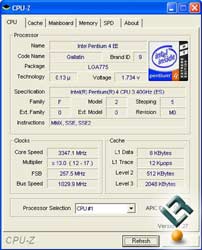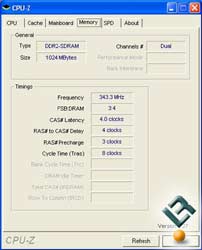ASUS P5GD2-Premium Motherboard
Testing: Overclocking
The overclocking experience with this motherboard gave me a few more gripes about this board. This includes my impression of the AI N.O.S. feature, which left me wondering just how functional it really is. Everything else that had to do with overclocking this board manually was satisfactory. We did not achieve the highest overclock around, but it was stable. We were on the internet and playing games over 1 GHz FSB!
AI N.O.S. Experience
Starting with my experience with AI N.O.S., allow me to give a quick run-through of my overclocking challenges on the P5GD2 Premium. As I mentioned in the BIOS section, enabling AI N.O.S. in the BIOS gave some unexpected effects. The main issue was the changing of the memory divider. Even after manually setting the memory divider to 3:4, booting into Windows and running CPU-Z showed us that the memory divider was currently running 1:1! Running a few tests confirmed that performance significantly dropped because of this. A few examples of this would be Everest Memory Read scores dropping to 4,256 MB/s from 4,665 MB/s and SuperPI 2M time dropped to 102 seconds from 98 seconds.
The second issue with AI N.O.S. was with its attempt to “auto-overclock” based on system need. After observing CPU-Z’s FSB frequency going up to about 215MHz and then suddenly dropping down to 202MHz (over and over again), I realized that system stability was going to be compromised. Sure enough, an attempt to run Half-Life 2 caused the system to crash and restart halfway through the timedemo. All of this was occuring on the lowest AI N.O.S. settings.
Manual Overclocking Experience
Manual overclocking was a little more functional. By increasing the FSB frequency, we found the max of the system to be 257 Mhz (roughly 1028 MHz Quad-pumped). Below are our CPU-Z screen shots at these speeds and using the 3:4 memory divider. You will notice that the screen shots show slightly higher than 1028 MHz FSB because the AI Proactive technologies add a few MHz to the system frequency just like ABIT’s uGuru and MSI’s CoreCell technologies. Never hurts to have that extra MHz advantage over the other guy running the same processor on a different motherboard!
We were also able to run a couple of benchmarks at 1028 MHz FSB: Everest Memory Bandwidth and Doom 3.
Everest

Doom 3

It seems that our decent overclock was able to pull out a few more valuable FPS in Doom 3. We also noticed a considerable increase in memory bandwidth scores for both read and write tests in Everest.



Comments are closed.